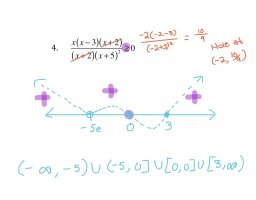The Velociraptors
New member
- Joined
- Jul 16, 2020
- Messages
- 48
Hi, I am attaching my work for a question below:
So I know this is wrong because apparently the hole is also on the number line. But I‘m confused on why this is so because the location of the hole is (2,10/9), and I thought the number line only accounts for coordinates on the x axis. Also, can you clarify if I’m supposed to take the holes into account when I’m finding the degree of the rational function? Is the degree of this rational function 4?

So I know this is wrong because apparently the hole is also on the number line. But I‘m confused on why this is so because the location of the hole is (2,10/9), and I thought the number line only accounts for coordinates on the x axis. Also, can you clarify if I’m supposed to take the holes into account when I’m finding the degree of the rational function? Is the degree of this rational function 4?

